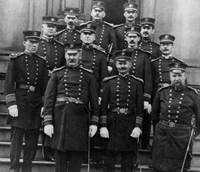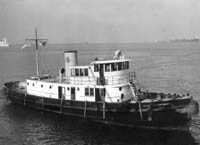History of Quarantine
The Middle Ages
The practice of quarantine, as we know it, began during the 14th century in an effort to protect coastal cities from plague epidemics. Ships arriving in Venice from infected ports were required to sit at anchor for 40 days before landing. This practice, called quarantine, was derived from the Italian words quaranta giorni which mean 40 days.
Early American Quarantine
When the United States was first established, little was done to prevent the importation of infectious diseases. Protection against imported diseases fell under local and state jurisdiction. Individual municipalities enacted a variety of quarantine regulations for arriving vessels.
State and local governments made sporadic attempts to impose quarantine requirements. Continued outbreaks of yellow fever finally prompted Congress to pass federal quarantine legislation in 1878. This legislation, while not conflicting with states' rights, paved the way for federal involvement in quarantine activities.
Late 19th Century
Outbreaks of cholera from passenger ships arriving from Europe prompted a reinterpretation of the law in 1892 to provide the federal government more authority in imposing quarantine requirements. The following year, Congress passed legislation that further clarified the federal role in quarantine activities. As local authorities came to realize the benefits of federal involvement, local quarantine stations were gradually turned over to the U.S. government. Additional federal facilities were built and the number of staff was increased to provide better coverage. The quarantine system was fully nationalized by 1921 when administration of the last quarantine station was transferred to the U.S. government.

U.S. Public Health Service Officers, like those shown in this image taken circa 1912, wore uniforms while performing quarantine station duties beginning in the late 19th Century. Photo courtesy of the National Library of Medicine.
Public Health Service Act
The Public Health Service Act of 1944 clearly established the federal government's quarantine authority for the first time. The act gave the U.S. Public Health Service (PHS) responsibility for preventing the introduction, transmission, and spread of communicable diseases from foreign countries into the United States.
Reorganization and Expansion
This PHS cutter ship was used to transport quarantine inspectors to board ships flying the yellow quarantine flag. The flag was flown until quarantine and customs personnel inspected and cleared the ship to dock at the port.
Originally part of the Treasury Department, Quarantine and PHS, its parent organization, became part of the Federal Security Agency in 1939. In 1953, PHS and Quarantine joined the Department of Health, Education, and Welfare (HEW). Quarantine was then transferred to the agency now known as the Centers for Disease Control and Prevention (CDC) in 1967. CDC remained part of HEW until 1980 when the department was reorganized into the Department of Health and Human Services.
When CDC assumed responsibility for Quarantine, it was a large organization with 55 quarantine stations and more than 500 staff members. Quarantine stations were located at every port, international airport, and major border crossing.

This PHS cutter ship was used to transport quarantine inspectors to board ships flying the yellow quarantine flag. The flag was flown until quarantine and customs personnel inspected and cleared the ship to dock at the port.
From Inspection to Intervention
After evaluating the quarantine program and its role in preventing disease transmission, CDC trimmed the program in the 1970s and changed its focus from routine inspection to program management and intervention. The new focus included an enhanced surveillance system to monitor the onset of epidemics abroad and a modernized inspection process to meet the changing needs of international traffic.
By 1995, all U.S. ports of entry were covered by only seven quarantine stations. A station was added in 1996 in Atlanta, Georgia, just before the city hosted the 1996 Summer Olympic Games. Following the severe acute respiratory syndrome (SARS) epidemic of 2003, CDC reorganized the quarantine station system, expanding to 18 stations with more than 90 field employees.
Quarantine Now
The Division of Global Migration and Quarantine is part of CDC's National Center for Emerging and Zoonotic Infectious Diseases and is headquartered in Atlanta. Quarantine stations are located in Anchorage, Atlanta, Boston, Chicago, Dallas, Detroit, El Paso, Honolulu, Houston, Los Angeles, Miami, Minneapolis, New York, Newark, Philadelphia, San Diego, San Francisco, San Juan, Seattle, and Washington, D.C. (see contact lists and map).
Under its delegated authority, the Division of Global Migration and Quarantine is empowered to detain, medically examine, or conditionally release individuals and wildlife suspected of carrying a communicable disease.
The list of quarantinable diseases is contained in an Executive Order of the President and includes cholera, diphtheria, infectious tuberculosis, plague, smallpox, yellow fever, viral hemorrhagic fevers (such as Marburg, Ebola, and Congo-Crimean), and severe acute respiratory syndromes.
Many other illnesses of public health signficance, such as measles, mumps, rubella, and chicken pox, are not contained in the list of quarantinable illnesses, but continue to pose a health risk to the public. Quarantine Station personnel respond to reports of ill travelers aboard airplanes, ships, and at land border crossings to make an assessment of the public health risk and initiate an appropriate response.

Signs like this one, for the El Paso Quarantine Station, identify the Quarantine Station facilities located in airports and at land border crossings.
- Page last reviewed: January 10, 2012
- Page last updated: July 31, 2014
- Content source:


 ShareCompartir
ShareCompartir